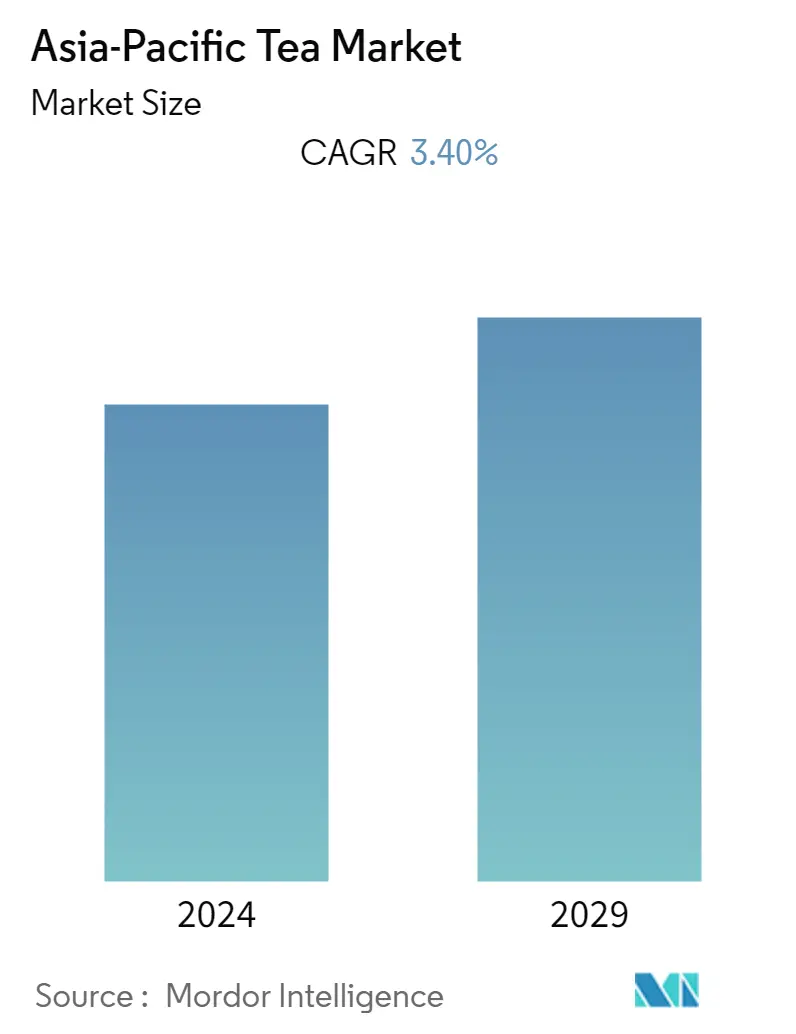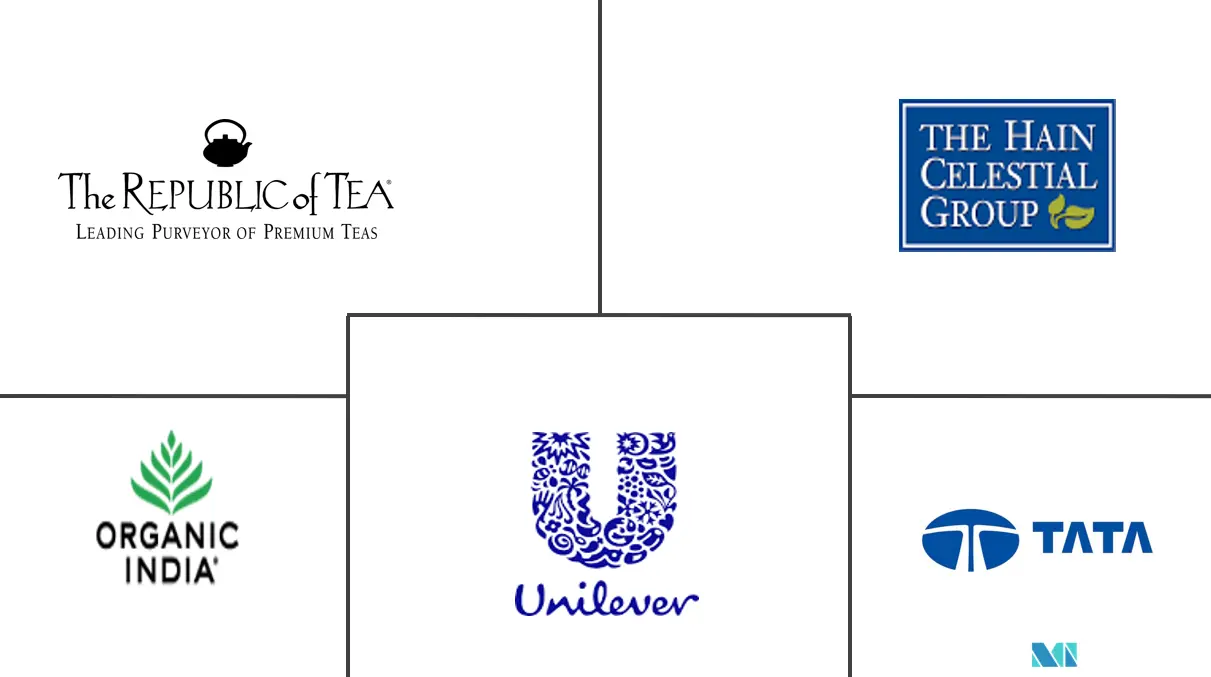Market Size of Asia-Pacific Tea Industry

| Study Period | 2019 - 2029 |
| Base Year For Estimation | 2023 |
| Forecast Data Period | 2024 - 2029 |
| Historical Data Period | 2019 - 2022 |
| CAGR | 3.40 % |
| Market Concentration | Low |
Major Players
*Disclaimer: Major Players sorted in no particular order |
Asia-Pacific Tea Market Analysis
Asia-Pacific Tea Market is witnessing a CAGR of 3.4% during the upcoming five years.
Tea is one of the most popular beverages in the Asia Pacific, especially in India. It is obtained from Camellia sinensis plant leaves. It offers various health benefits owing to the presence of polyphenols working as antioxidants, vitamins, trace minerals, and different amino acids resulting in stronger immunity, lower cholesterol, increased metabolism, and more. The growing inclination of demand from traditional tea to premiumization is expected to grow in the years to come. India, China, and Japan are among the top consumers of tea. The tea market is majorly driven by the health benefits associated with consuming tea and the increase in awareness related to the adverse impacts pertaining to the consumption of carbonated drinks. Moreover, the rise in disposable income, changes in the tastes of people, and the introduction of additional healthy ingredients in tea by different market players are the other factors that fuel the market growth. However, an increase in the cost of raw materials due to unpredictable weather, a rise in the cost of agricultural inputs, and an increase in the trend of coffee consumption is expected to limit the growth of the tea market.
Online retailing of organic tea products is the current profound channel for tea manufacturers, when it comes to distribution and marketing. The companies are inclining toward online stores to get better access to consumers having lack of physical outlets in remote areas. Moreover, many new startups and entrepreneurs are rather choosing this point of sale to launch their products, due to the less capital investment required and high consumer base covered.
For instance, In 2022, Luxmi Tea Company Private Ltd. scaled up operations and started selling its teas directly to consumers both through its online site, and other marketplaces and through retail stores. Moreover organic tea is also growing in the region owing to the increasing consumer awareness regarding clean-label foods such as pesticide-free commodities. The organic tea production is increasing due to the perceived higher quality along with the benefits for human wellbeing.
Asia-Pacific Tea Industry Segmentation
Tea is an aromatic beverage prepared by pouring hot or boiling water over cured or fresh leaves of Camellia sinensis, an evergreen shrub native to East Asia. By form, the market has been segmented into Leaf Tea and CTC Tea (Crush, Tear, Curl). By product type, the market has been segmented into Black tea, Green tea, Herbal tea, and Others. By distribution channel, the market has been segmented into Supermarkets/Hypermarkets, Convenience/Grocery Stores, Specialty Stores, Online Retail Stores, and Other Distribution Channels). Also, the study provides an analysis of the tea market in the emerging and established markets across the Asia-Pacific region, including countries such as China, Japan, India, Australia, and the Rest of Asia-Pacific. For each segment, the market sizing and forecasts have been done on the basis of value (in USD million).
| By Form | |
| Leaf Tea | |
| CTC Tea |
| By Product Type | |
| Black Tea | |
| Green Tea | |
| Herbal Tea | |
| Others |
| By Distribution Channel | |
| Supermarkets/Hypermarkets | |
| Convenience/Grocery Stores | |
| Specialty Stores | |
| Online Retail Stores | |
| Other Distribution Channels |
| Country | |
| China | |
| Japan | |
| India | |
| Australia | |
| Rest of Asia-Pacific |
Asia-Pacific Tea Market Size Summary
The Asia-Pacific tea market is experiencing steady growth, driven by the increasing popularity of tea as a health-conscious beverage choice. This trend is particularly evident in countries like India, China, and Japan, where tea consumption is deeply rooted in culture. The market is characterized by a shift from traditional tea to premium and organic varieties, as consumers become more aware of the health benefits associated with tea, such as improved immunity and metabolism. The rise in disposable income and changing consumer preferences towards healthier options are further propelling market expansion. However, challenges such as fluctuating raw material costs and the growing trend of coffee consumption may pose limitations to market growth.
The distribution landscape of the Asia-Pacific tea market is evolving, with online retailing emerging as a significant channel for reaching consumers, especially in areas with limited physical retail presence. Companies are increasingly leveraging e-commerce platforms to expand their reach and cater to the growing demand for organic and premium tea products. The market is also witnessing a surge in black tea consumption, driven by its perceived health benefits and the influence of Western trends. Key players in the market, including Unilever, Tata Global Beverages, and Organic India, are actively engaging in strategies such as product innovation, mergers, and partnerships to strengthen their market position. The competitive and fragmented nature of the market underscores the dynamic landscape, with both regional and international players vying for consumer attention and market share.
Asia-Pacific Tea Market Size - Table of Contents
-
1. MARKET DYNAMICS
-
1.1 Market Drivers
-
1.2 Market Restraints
-
1.3 Porter's Five Forces Analysis
-
1.3.1 Bargaining Power of Suppliers
-
1.3.2 Bargaining Power of Buyers/Consumers
-
1.3.3 Threat of New Entrants
-
1.3.4 Threat of Substitute Products
-
1.3.5 Intensity of Competitive Rivalry
-
-
-
2. MARKET SEGMENTATION
-
2.1 By Form
-
2.1.1 Leaf Tea
-
2.1.2 CTC Tea
-
-
2.2 By Product Type
-
2.2.1 Black Tea
-
2.2.2 Green Tea
-
2.2.3 Herbal Tea
-
2.2.4 Others
-
-
2.3 By Distribution Channel
-
2.3.1 Supermarkets/Hypermarkets
-
2.3.2 Convenience/Grocery Stores
-
2.3.3 Specialty Stores
-
2.3.4 Online Retail Stores
-
2.3.5 Other Distribution Channels
-
-
2.4 Country
-
2.4.1 China
-
2.4.2 Japan
-
2.4.3 India
-
2.4.4 Australia
-
2.4.5 Rest of Asia-Pacific
-
-
Asia-Pacific Tea Market Size FAQs
What is the current Asia-Pacific Tea Market size?
The Asia-Pacific Tea Market is projected to register a CAGR of 3.40% during the forecast period (2024-2029)
Who are the key players in Asia-Pacific Tea Market?
Unilever PLC, Tata Global Beverages, The Hain Celestial Group, Inc., The Republic of Tea and Organic India are the major companies operating in the Asia-Pacific Tea Market.

